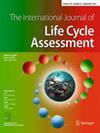Increasing temporal resolution in greenhouse gas accounting of electricity consumption divided into Scopes 2 and 3: case study of Germany
IF 5.4
3区 环境科学与生态学
Q2 ENGINEERING, ENVIRONMENTAL
引用次数: 0
Abstract
Abstract Purpose As renewable energy sources (RES) experience short-term variability, electricity greenhouse gas (GHG) emissions also fluctuate. Increasing temporal resolution in electricity emissions accounting allows capturing these fluctuations. However, existing time-resolved models either neglect indirect impacts, adopt a generation perspective, or are based on non-public country-specific data. We provide an approach for calculating time-resolved GHG emission factors (EFs) of electricity consumption based on open access data for European countries and examine the temporal variability of German EFs. Methods Time-resolved electricity GHG EFs are calculated within the framework of attributional life cycle assessment (LCA) with up to quarter-hourly resolution. The approach involves top-down calculation of annual combustion emissions, validation and scaling of time-resolved electricity generation data, as well as calculation of inland consumption EFs for each interval throughout a year. The EFs are divided by the stages of net generation, consumption by hydro-pumped storage (HPS), and transmission and distribution (T&D) losses, as well as Scopes 2 and 3, enabling GHG Protocol Corporate Standard-compliant reporting. The approach is exemplarily applied to Germany and its transmission system operator zones at quarter-hourly resolution for the years from 2017 to 2020 to investigate the relation between grid mix composition and temporal variability of EFs. Results and discussion The annual average EF of the German consumption mix, encompassing direct and upstream emissions, declined from 499 (2017) to 377 g CO 2 e/kWh (2020), while quarter-hourly variability increased by 12%. Neglecting upstream emissions and intermediate steps between generation and consumption in Germany in 2020 resulted in an underestimation of 13% on an annual level, while quarter-hourly Scope 3 EFs reached up to 100 g CO 2 e/kWh. On a sub-national level, annual average EFs varied between 157 g CO 2 e/kWh (TenneT zone) and 505 g CO 2 e/kWh (50Hertz zone) in 2020. Temporal variability is the greatest in electricity systems with both fossil-fuel and renewable capacity sufficient to dominate short-term electricity generation. At an advanced level of RES integration, the fluctuations of EFs start declining, as demonstrated by the TenneT case. Conclusion An increased temporal resolution in electricity emissions accounting can enhance a posteriori LCA results’ accuracy during the energy transition phase. The provided EFs link the life cycle-based perspective with time-resolved emissions accounting. With increasing reliance on RES, indirect emissions, including those related to energy storage, will gain in significance. The next step should focus on integrating physical cross-border electricity exchanges to complete the consumption perspective, as well as examining practical implementation to other countries.增加电力消耗温室气体核算的时间分辨率分为范围2和范围3:德国的案例研究
摘要目的由于可再生能源(RES)具有短期变异性,电力温室气体(GHG)排放也具有波动性。在电力排放核算中增加时间分辨率可以捕捉这些波动。然而,现有的时间分辨模型要么忽略了间接影响,要么采用世代视角,要么基于非公开的国别数据。我们提供了一种基于欧洲国家开放获取数据计算电力消耗的时间分辨温室气体排放因子(EFs)的方法,并研究了德国EFs的时间变动性。方法在归因生命周期评价(LCA)框架下,以四分之一小时的分辨率计算时间分辨电温室气体效应。该方法涉及自上而下的年度燃烧排放计算,时间分辨发电数据的验证和缩放,以及全年每个间隔的内陆消耗EFs计算。EFs按净发电阶段、抽水蓄能(HPS)消耗阶段、输配电(T&D)损耗阶段以及范围2和范围3进行划分,从而实现符合温室气体协议公司标准的报告。该方法以2017年至2020年德国及其输电系统运营商区域为例,以四分之一小时分辨率研究电网混合组成与EFs时间变化之间的关系。德国消费组合的年平均EF,包括直接和上游排放,从499(2017年)下降到377 g co2 e/kWh(2020年),而季度每小时的变化增加了12%。2020年,德国忽略了上游排放和发电和消费之间的中间步骤,导致年度水平低估了13%,而每季度范围3的EFs高达100克co2 e/kWh。在次国家层面,2020年的年平均排放量在157 g CO 2 e/kWh (TenneT区)和505 g CO 2 e/kWh (50Hertz区)之间变化。电力系统的时间变异性最大,因为化石燃料和可再生能源的发电能力都足以主导短期发电。如TenneT案例所示,在RES集成的高级水平上,EFs的波动开始下降。结论提高电力排放核算的时间分辨率可以提高能源转型阶段后验LCA结果的准确性。所提供的EFs将基于生命周期的观点与时间解决的排放核算联系起来。随着对可再生能源的依赖日益增加,间接排放,包括与能源储存有关的排放,将变得越来越重要。下一步应侧重于整合实体跨境电力交易,以完成消费视角,并研究在其他国家的实际实施情况。
本文章由计算机程序翻译,如有差异,请以英文原文为准。
求助全文
约1分钟内获得全文
求助全文
来源期刊
CiteScore
10.60
自引率
10.40%
发文量
100
审稿时长
8-16 weeks
期刊介绍:
The International Journal of Life Cycle Assessment (Int J Life Cycle Assess) is the first journal devoted entirely to Life Cycle Assessment and closely related methods. LCA has become a recognized instrument to assess the ecological burdens and impacts throughout the consecutive and interlinked stages of a product system, from raw material acquisition or generation from natural resources, through production and use to final disposal. The Int J Life Cycle Assess is a forum for scientists developing LCA and LCM (Life Cycle Management); LCA and LCM practitioners; managers concerned with environmental aspects of products; governmental environmental agencies responsible for product quality; scientific and industrial societies involved in LCA development, and ecological institutions and bodies.

 求助内容:
求助内容: 应助结果提醒方式:
应助结果提醒方式:


